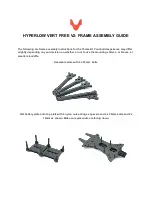
Cold Crank 97 Chrysler Intrepid 85000 Miles
- J z . m f l r 2 —
A
6
Cold Crank Test
This is the single most important test you can run. Knowing
the basic condition of an engine can save you many hours of
work and get you to the actual problem much faster.
Starting Scope settings
1.
Depending on cranking RPM time base will be .5 second to
1 second. sweep of scope screen.
2.
Set scope to AC signal.
3.
Starting voltage range .5 + or -.
4.
Disable fuel pump or in the case of carbureted engine
disable spark.
5.
Insert black end of hose with springs about 5 to 8 inches into
tail pipe.
6.
Crank Engine to determine best voltage setting.
7.
Once you have determined best setting crank engine and
freeze the screen to examine the pattern.
This waveform shows a typical high mileage engine. The engine is
in good shape with a small amount of valve leakage. Small
irregularities can indicate dirty or worn valves. Major problems
will show up as major fluctuations in the scope pattern. This is a
quick simple test to determine basic engine condition. Once you
determine that you have a major problem you can now proceed
to concentrate your resources in that area.
Idle Test
This test allows a mechanic to identify a problem that is specific to a
particular cylinder using a trigger signal. It also allows you to look for
intermittent problems more easily because you are actually watching
the engine running in real time.
Starting Scope Settings
1.
Idle test… 650 to 700 RPM…Scope settings.
2.
Set Scope to AC signal
3.
Voltage settings… +1 Volts to – 1 Volts
4.
Time base … 200 ms
5.
Insert black end of hose with springs about 5 to 8 inches into tail pipe.
8.
Start Engine and adjust voltage for best display of waveform.
9.
Start Engine and allow idle to stabilize.
10.
Freeze the screen to examine the pattern.
11.
This test was run using #1 plug as trigger reference
2001 Chevrolet Impala 6 cylinder Engine
Firing Order 1-2-3-4-5-6
Remember cylinder offset
#5 Cylinder misfire
It is important that if you have multiple problems to solve each
problem in order and rerun the test to determine the next problem.
3






















